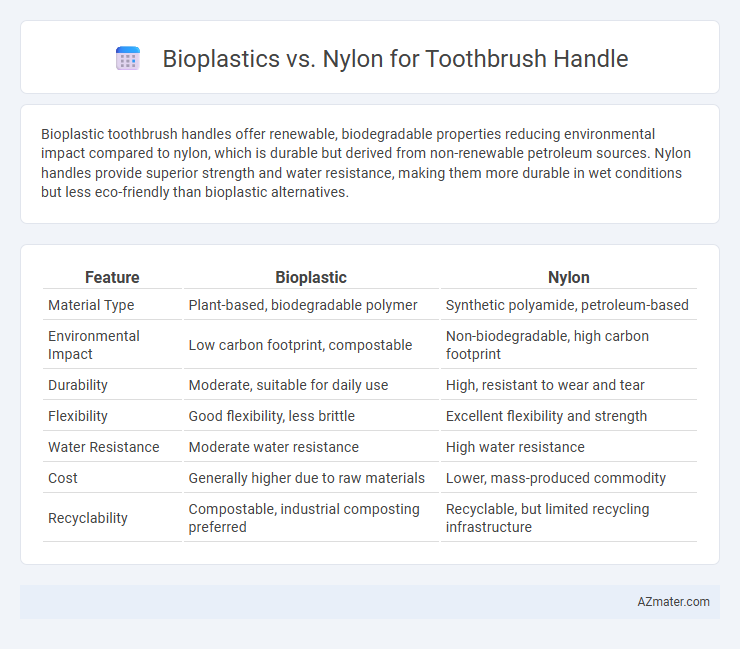Bioplastic toothbrush handles offer renewable, biodegradable properties reducing environmental impact compared to nylon, which is durable but derived from non-renewable petroleum sources. Nylon handles provide superior strength and water resistance, making them more durable in wet conditions but less eco-friendly than bioplastic alternatives.
Table of Comparison
| Feature | Bioplastic | Nylon |
|---|---|---|
| Material Type | Plant-based, biodegradable polymer | Synthetic polyamide, petroleum-based |
| Environmental Impact | Low carbon footprint, compostable | Non-biodegradable, high carbon footprint |
| Durability | Moderate, suitable for daily use | High, resistant to wear and tear |
| Flexibility | Good flexibility, less brittle | Excellent flexibility and strength |
| Water Resistance | Moderate water resistance | High water resistance |
| Cost | Generally higher due to raw materials | Lower, mass-produced commodity |
| Recyclability | Compostable, industrial composting preferred | Recyclable, but limited recycling infrastructure |
Introduction: Bioplastics and Nylon in Toothbrush Handles
Bioplastics for toothbrush handles are derived from renewable biomass sources such as corn starch or sugarcane, offering biodegradable and eco-friendly properties that reduce environmental impact compared to conventional plastics. Nylon, a synthetic polymer known for its strength, durability, and resistance to moisture, provides long-lasting functionality but is petroleum-based and less sustainable. The choice between bioplastic and nylon balances environmental considerations with performance needs in toothbrush handle manufacturing.
Material Composition: Bioplastic vs Nylon
Bioplastic toothbrush handles are primarily composed of renewable plant-based polymers such as polylactic acid (PLA), which offer biodegradability and reduced carbon footprint. Nylon handles, made from synthetic polyamides, provide high durability, flexibility, and resistance to wear but rely on fossil fuels and have limited recyclability. Choosing bioplastic supports sustainability goals, while nylon emphasizes performance and longevity in toothbrush handle materials.
Manufacturing Processes Compared
The manufacturing process of bioplastic toothbrush handles involves the use of renewable raw materials like cornstarch or sugarcane, which are melted and molded through injection molding or extrusion methods, resulting in biodegradable and sustainable products. Nylon toothbrush handles require the polymerization of caprolactam to create nylon pellets, which are then injection molded into durable and flexible handles, but they rely on fossil fuel-derived materials. Bioplastics often demand lower energy consumption and emit fewer greenhouse gases during manufacturing compared to the high-temperature processing and energy-intensive production of nylon handles.
Environmental Impact and Sustainability
Bioplastic toothbrush handles offer a significant advantage over nylon in terms of environmental impact due to their biodegradability and derivation from renewable resources like cornstarch or sugarcane, which reduces reliance on fossil fuels and decreases plastic pollution. Nylon, a petroleum-based polymer, contributes to microplastic contamination and has a higher carbon footprint due to its energy-intensive production process and resistance to natural degradation. Choosing bioplastic promotes sustainability by supporting circular economy principles, enabling composting or recycling, and lowering greenhouse gas emissions throughout the product lifecycle.
Durability and Performance in Daily Use
Bioplastic toothbrush handles offer moderate durability with biodegradability but may wear faster under constant moisture compared to nylon, which provides superior strength and resistance to cracking or deformation. Nylon handles maintain structural integrity longer in daily use, resisting impact and temperature changes, making them ideal for repeated handling and pressure. Performance-wise, nylon supports a stable grip and consistent use, whereas bioplastic handles may degrade or soften over time, potentially affecting usability.
Biodegradability and End-of-Life Scenarios
Bioplastic toothbrush handles exhibit superior biodegradability compared to nylon, breaking down naturally under industrial composting conditions within months, whereas nylon can persist in the environment for decades due to its synthetic polymer structure. Bioplastics derived from renewable resources like PLA or PHA decompose into water, carbon dioxide, and biomass, reducing landfill mass and microplastic pollution associated with nylon handles. End-of-life scenarios for bioplastic toothbrushes favor composting and organic recycling, contrasting with nylon handles that require energy-intensive recycling or contribute to long-term plastic waste accumulation.
Cost Analysis: Production and Market Price
Bioplastic toothbrush handles typically incur higher production costs due to the use of renewable raw materials and more complex manufacturing processes compared to nylon, which benefits from established petrochemical supply chains and mass production efficiencies. Market prices for bioplastic handles tend to be 15-30% higher than nylon counterparts, reflecting the premium placed on sustainability and lower environmental impact. Despite the higher cost, growing consumer demand and regulatory incentives are driving economies of scale that may reduce bioplastic prices over time.
Consumer Safety and Health Considerations
Bioplastic toothbrush handles offer a safer alternative to nylon by using plant-based materials that reduce exposure to toxic chemicals commonly found in synthetic polymers. Nylon handles may release trace amounts of harmful additives like plasticizers and stabilizers, raising concerns over long-term health effects with daily use. Consumers prioritizing health and environmental impact should consider bioplastic options that minimize chemical leaching and promote biodegradability.
Industry Trends and Innovations
Bioplastic toothbrush handles are gaining traction in the personal care industry due to their renewable raw materials and biodegradability, aligning with growing consumer demand for sustainable products. Innovations in bio-based polymers, such as polylactic acid (PLA) blends, improve durability and water resistance, making bioplastics a viable alternative to traditional nylon handles. Meanwhile, nylon remains prevalent for its strength and flexibility, but industry trends increasingly favor hybrid materials combining bioplastics with nylon to balance performance and eco-friendliness.
Conclusion: Choosing the Right Material for Toothbrush Handles
Bioplastic toothbrush handles offer eco-friendly benefits with biodegradability and reduced carbon footprint, making them ideal for sustainable oral care choices. Nylon handles provide superior durability and strength, ensuring long-lasting use and resistance to wear and moisture. Selecting the right material depends on prioritizing environmental impact versus longevity, with bioplastics favoring sustainability and nylon emphasizing performance.

Infographic: Bioplastic vs Nylon for Toothbrush handle
 azmater.com
azmater.com